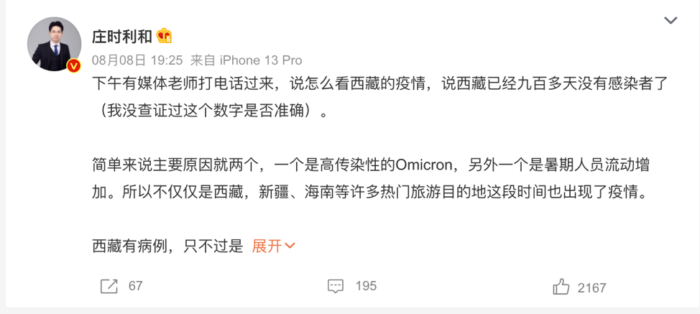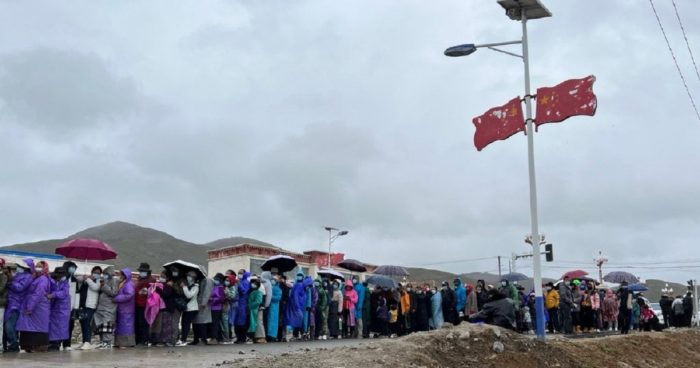The reported COVID-19 outbreaks in Tibet may be the result of Chinese tourism encouraged by the Chinese government, according to observers inside Tibet.
Commenters have also been complaining about inadequate infrastructure to combat the pandemic in Tibet.
Although China almost never allows journalists, diplomats and tourists from other countries to visit Tibet, it has encouraged Chinese tourists to travel to the region as part of Beijing’s intensifying campaign to assimilate Tibet into Chinese society.
Lockdowns
China’s authorities in the Tibet Autonomous Region – which spans about half of Tibet – have placed the entire population of 800,000 in Shigatse prefecture-level city under a three-day complete lockdown. The authorities have also imposed partial lockdowns in Lhasa, Tibet’s capital, Nyingtri (Chinese: Linzhi) and Lhoka (Shannan) after detecting several COVID cases in the TAR since 6 August.
According to Chinese state media, beginning with four positive cases in the western Tibetan town of Purang (Pulan) county in Ngari (Ali) on 6 August, more cases have been detected so far in Shigatse, Lhasa, Nyingtri and Lhoka.
As of 11 August, there have been more than 25 positive cases.
Going by state media reports about preparation being made for COVID testing in not only the above areas, but also in Nagchu (Naqu) and Chamdo (Changdu) as well as makeshift hospitals in Chamdo, the areas infected may be larger than that are being reported.
Domestic Tourism as possible cause
Details about the individuals with COVID, including their origin, have not been made public, other than that they have contracted the Omicron variant strain BA.2.76.
All the individuals infected are reported to have been travelers, including on the train route between Shigatse and Lhasa, as well as between Lhasa and Nyingtri.
Even before the stringent restrictions imposed by Chinese authorities under their “dynamic zero-COVID policy,” Tibet has been under a virtual lockdown. The region has been closed to foreign tourists for several years.
Despite China’s tight censorship on social media posts, since the most recent COVID cases, some have pointed their fingers at these tourists as the possible cause of the outbreaks. One such post on Aug. 8 said, “In short, there are two main reasons, one is the highly infectious Omicron, and the other is the increase in the flow of people during the summer vacation. Therefore, not only Tibet, but also many popular tourist destinations such as Xinjiang and Hainan have also experienced epidemics during this period.”

In a preemptive deflection of attention and criticism from the large influx and presence of Chinese visitors, Global Times, a state media outlet, has even carried a report hinting at neighboring countries as the possible source of infection. “As Xigaze [Chinese spelling of Shigatse] is a city bordering India, Nepal and Bhutan, the possibility of infection through trade cannot be ruled out,” Global Times reported on 8 August.
Complaints of inadequate infrastructure
The latest COVID cases reported in these Tibetan cities have revealed the inadequacies of infrastructure preparation to combat the pandemic.
While authorities required the public to undergo mandatory mass COVID testing in the wake of the outbreak, there were not enough venues and facilities for testing. As a result, people complained of having to waste time standing in long lines for the mandatory tests.
One post on Chinese social media on 9 August reflected the situation at a testing site, saying: “It was chaotic and disorderly. Some Tibetans really like to cut the queue, and there was a Han woman who also cut the queue… My feeling of anger even cured my altitude sickness. Nucleic acid personnel are very irregular, gloves are not sterilized, and they touch everyone’s lips… Then hand-copy the ID number for registration.”
编号223 08月09日 19:30 @杨晓春 转发过 来自 iPhone 13 Pro Max
海拔4600,6度雨天,5个小时,做了人生中最艰难的一次核酸,混乱无序,有些藏人真的很爱插队 ,还有个汉人女子也插队。。。气得高反都好了。核酸人员非常不规范,手套不消毒,还触碰到每个人的嘴唇。。。然后,,,手抄身份证号登记。。。 现场视频就不发了,简直丧尸炼狱。。。
A video clip shared on Twitter shows a long queue of Tibetans in Lhasa waiting for administration of the mandatory COVID testing on the morning of 8 August.
Not the first cases in Tibet
Although these are the first reported COVID cases in the Tibet Autonomous Region since 2020, there have been COVID-positive cases in other Tibetan areas since that year. These include Tibetans in the Amdo area of Tsongon (Qinghai); Kardze (Ganzi), Tawu (Daofu), Sertha (Seda), Dartsedo (Kangding), Dabpa (Daocheng) and Ngaba (Aba) in Sichuan; and Kanlho (Gannan).
In 2020, Chinese authorities responded to the spread of coronavirus to Tibet by cracking down on people who posted information online about the deadly illness, including one man who was detained by police simply for encouraging his contacts to recite prayers to ward off infection.
Restrictions imposed in Tibet
Below is information about the places that have reportedly had positive COVID cases. In all these areas, what the Chinese authorities term “silent management” (when public places are closed and movement is strictly restricted) is implemented in areas identified as medium- and high-risk, while people in low-risk areas must hold a negative nucleic acid test report (a green QR code) within 48 hours for cross-city movement.
In Shigatse, the authorities announced on 8 August three days of “silent management” in the region, which in effect puts the entire population of 800,000 under lockdown. On 11 August, this was extended for an additional three days.
In Ngari and Shigatse, 14 areas have been designated as high-risk and 12 areas as medium-risk.
Parts of Lhasa around the Chengguan district have been designated as medium-to high-risk zones (one high-risk and 15 medium-risk).
The Lhasa Buddhist Association announced the closure of all Tibetan Buddhist venues and suspended all religious activities in the city. The iconic Potala Palace is also closed, along with other temples and monasteries in the city. The association notice did not specify the duration of the closure and suspension of religious activity measures.
In Nyingtri, three areas have been declared as high-risk and 12 areas as medium-risk. All religious venues are temporarily closed, as are theaters and gyms, as well as all kinds of public cultural and sports venues.
In Lhoka, two areas in Tsethang have been declared high-risk and one area as medium-risk on 11 August.

Tibetans in Lhasa queuing late into the night on 8 August for the mandatory COVID testing (image via Weibo)